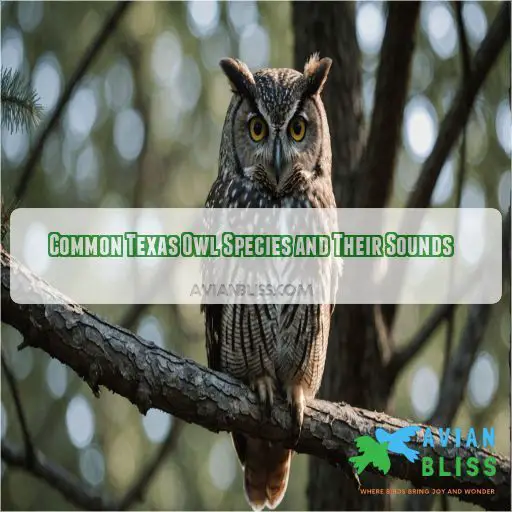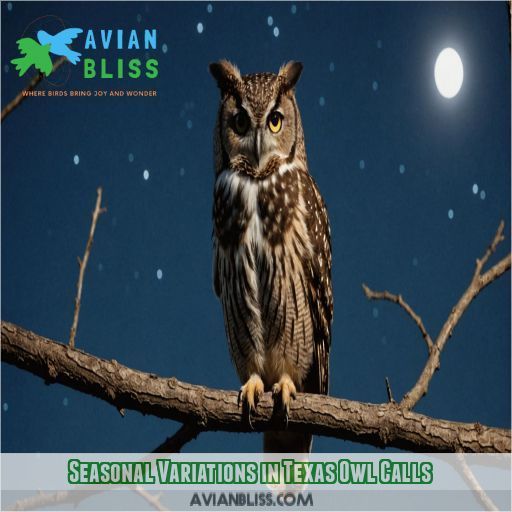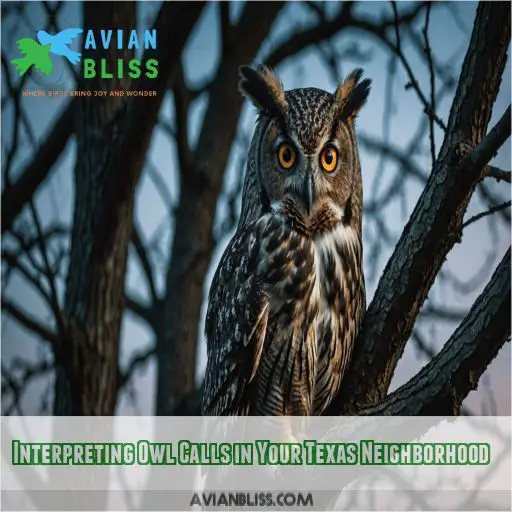This site is supported by our readers. We may earn a commission, at no cost to you, if you purchase through links.

But there’s more to these nocturnal serenades than meets the ear. Stay tuned to discover the secrets behind these mysterious calls.
Table Of Contents
- Key Takeaways
- Common Texas Owl Species and Their Sounds
- Texas Owl Sound Identification Guide
- Seasonal Variations in Texas Owl Calls
- Interpreting Owl Calls in Your Texas Neighborhood
- Texas Owl Habitats and Sound Environments
- Owl Call Recording and Observation Techniques
- Conservation and Texas Owl Sound Preservation
- Frequently Asked Questions (FAQs)
- What kind of owls hoot in Texas?
- Which owl makes a hoo hoo sound?
- What does it mean when an owl is hooting outside your house?
- What bird makes a woo hoo sound?
- Do owls only call at night?
- How can I identify an owl by its call?
- What do owl calls mean?
- Why cant I see owls during the day?
- Are owl calls ever dangerous?
- Conclusion
Key Takeaways
- Texas is home to a diverse range of owl species, each with its own unique and fascinating call, from the iconic "who cooks for you?" of the Barred Owl to the soft coos of the Burrowing Owl.
- Owl calls serve multiple purposes, including territorial disputes, mating rituals, and parent-offspring communication. These birds are also masters of adaptation, adjusting their calls to different habitats and seasons.
- Human activities, such as urban sprawl, climate change, and noise pollution, pose significant threats to owl populations and their habitats. Conservation efforts, including citizen science projects and educational initiatives, are vital to protecting these majestic night callers.
- You can identify owls by their distinctive calls and hoots, and interpreting these calls can give you a fascinating insight into the secret world of owl communication right in your own backyard.
Common Texas Owl Species and Their Sounds
Texas is home to a diverse array of owl species, including the imposing Great Horned Owl, which can be found on the Native Owls of Texas. You’re in for a treat as we explore the eerie night calls of Texas’s most common owl species. From the classic hoots of the Great Horned Owl to the spine-tingling screams of the Barn Owl, you’ll discover the unique voices that make Texas nights come alive with mysterious melodies.
Great Horned Owl: the Classic Hooting Owl
You’re in for a hoot with the Great Horned Owl, Texas’s nocturnal rockstar! This classic hooter’s deep, resonant calls will send shivers down your spine. Here’s what makes them the talk of the woods:
- Their hoots sound like a muffled foghorn, perfect for spine-tingling nighttime serenades.
- They’re master vocalists, able to mimic other owl species and even human voices.
- Their calls carry for miles, making them the town criers of the forest.
Barred Owl: Who Cooks for You?
You’ve probably heard the Barred Owl’s iconic "Who cooks for you?" call echoing through Texas woods.
These chatty birds are masters of vocal variety, throwing in cackles and gurgles that’ll make you think you’re at a woodland comedy club.
Found across eastern Texas, they’re adapting to city life too.
Keep an ear out – their conversations might just be the best entertainment on a quiet night!
Eastern Screech-Owl: Trills and Whinnies
You’ll be charmed by the Eastern Screech-Owl’s repertoire of trills and whinnies. These pint-sized predators are masters of vocal disguise, adapting their calls to their habitat. Here’s a quick guide to their sounds:
- Descending whinny: territorial defense
- Monotone trill: mating call
- Soft, low hoots: pair bonding
- Bark-like alarm call: danger alert
Whether in urban parks or dense forests, these owls’ eerie melodies will keep you hooting with excitement!
Barn Owl: Eerie Screams and Hisses
You might think Barn Owls are elegant, but their calls are anything but! These ghostly birds make blood-curdling screams that’ll send shivers down your spine. They’re masters of the night, using their eerie vocalizations for everything from wooing mates to warning off intruders.
| Call Type | Description | Purpose |
|---|---|---|
| Screech | High-pitched, raspy | Territorial defense |
| Hiss | Snake-like, breathy | Threat response |
| Chirp | Short, repetitive | Nestling begging |
Burrowing Owl: Soft Coos and Rattles
You mightn’t expect it, but the tiny Burrowing Owl packs a punch in the sound department. Unlike its tree-dwelling cousins, this pint-sized owl calls from the ground. Listen for soft "coo-coooo" sounds that’ll make you swoon. But here’s the kicker – when threatened, they’ll mimic a rattlesnake’s buzz! Talk about a clever defense mechanism that’ll keep predators on their toes.
Texas Owl Sound Identification Guide
- Listen for the "who-cooks-for-you" of the Barred Owl
- Distinguish the deep hoots of the Great Horned Owl
- Catch the eerie scream of the Barn Owl
- Pick up on the trilling whinny of the Eastern Screech Owl
- Notice the soft coos of the Burrowing Owl
With practice, you’ll be able to tell these night voices apart like a pro. Remember, owl call variations can throw you off, so keep your ears peeled for subtle differences. And hey, why not turn your newfound skills into a fun family activity? Grab your phone, download an owl sound app, and head out for a nocturnal adventure in owl call identification!
Seasonal Variations in Texas Owl Calls
You’ll notice that Texas owls don’t hoot the same way all year round. Their calls change with the seasons, from the increased vocal activity during breeding to the territorial hoots of winter, and even shifts during migration periods.
Breeding Season: Increased Vocal Activity
Texas owls get loud during breeding season.
They serenade potential mates with their calls.
It’s like a feathered karaoke night!
Listen for male owls calling to attract females and establish nesting spots.
As the season progresses, you’ll hear duets between pairs and even the peeps of hungry chicks.
Winter Months: Territorial Hooting
As winter’s chill sets in, you’ll notice Texas owls ramping up their vocal game.
It’s like they’re turning up the volume on their territorial radio!
Great Horned Owls lead the charge, their deep hoots echoing through the crisp night air.
You might hear Barred Owls joining the chorus, their "who-cooks-for-you" calls adding to the winter symphony.
This seasonal serenade isn’t just for show—it’s all about staking claims and finding mates in the frosty Lone Star State.
Migration Periods: Changes in Owl Populations
As winter fades, you’ll notice changes in owl populations across Texas.
Some species, like Short-eared Owls, pack their bags and head north to breeding grounds.
Others, such as Burrowing Owls, might shuffle around the state seeking prime nesting spots.
Keep your ears peeled for new hoots in the hood—you might just catch the arrival of a feathered traveler or the departure of a winter resident.
Interpreting Owl Calls in Your Texas Neighborhood
You’ll be amazed at the secret world of owl communication happening right in your Texas backyard. From territorial disputes to mating rituals, learning to interpret these eerie calls will give you a whole new appreciation for your nocturnal neighbors.
Territorial Disputes and Warnings
As the seasons change, so do the reasons for owl calls. When you’re out at night, you might hear some feathery feuds! Owls use their voices to draw lines in the sky, letting others know, "This tree’s mine!" Here are some telltale signs of owl territorial disputes:
- Increased frequency of hooting
- Rapid-fire call sequences
- Aggressive, low-pitched growls
- Dueling calls between two owls
- Sudden bursts of loud vocalizations
These vocal battles are nature’s way of keeping the peace without ruffling too many feathers.
Mating Rituals and Pair Bonding
Texas owls put on quite a show when love is in the air.
You’ll hear passionate hoots and haunting duets as these feathered Romeos woo their Juliets.
Great Horned Owls exchange deep, resonant calls.
Barred Owls perform their famous "who-cooks-for-you" serenade.
Listen closely, and you might catch the sweet trills of Eastern Screech-Owls as they cement their bond.
It’s nature’s own love song, right in your backyard!
Parent-Offspring Communication
Owl communication takes on a whole new meaning when it comes to parent-offspring interactions.
As nestlings grow, they’ll chirp for food, and parents respond with soft hoots.
It’s like a feathery family FaceTime!
Listen for high-pitched begging calls from fledglings learning to hunt.
These sounds change as chicks develop, giving you a peek into their growth.
It’s nature’s own reality show, right in your backyard!
Distress Calls and Predator Alerts
Owls, despite being the ones causing a ruckus, are not immune to danger themselves.
You might hear distress calls that’ll make your hair stand on end – these are their "SOS" signals.
Some clever owls even mimic other animals to scare off predators.
It’s like nature’s version of a home security system!
Texas Owl Habitats and Sound Environments
You’ll be amazed by how Texas owls adapt their calls to different habitats across the Lone Star State. From the echoing hoots in dense forests to the haunting screams carried over coastal wetlands, each environment shapes the eerie nighttime symphony you might hear in your own backyard.
Urban and Suburban Owl Adaptations
You’ve heard the hoots in your neighborhood, but did you know owls are adapting to urban life? These night hunters are learning to thrive in our concrete jungles. Here’s how they’re adjusting:
- Tuning out the racket: Owls filter urban sounds to focus on prey.
- Fast food finds: They’re snacking on rats and pigeons.
- High-rise homes: Owls nest in buildings and tall trees.
- Light night hunting: Streetlights help them spot meals.
It’s a hoot how these feathered friends are making themselves at home!
Forest and Woodland Owl Acoustics
Texas’s forests and woodlands are buzzing with owl activity.
These feathered night-watchers have mastered the art of sound in their leafy domains.
Their calls bounce off trees, creating a natural amphitheater.
It’s like they’ve got their own surround-sound system!
But it’s not all hoots and hollers.
Some owls are expert mimics, throwing their voices to confuse predators and prey alike.
Talk about a wild party in the woods!
Grassland and Prairie Owl Vocalizations
You’re in for a treat when you venture into Texas’s grasslands and prairies! These wide-open spaces are a playground for some unique owl vocalizations. Here’s what you might hear:
- The soft "coo-coooo" of a Burrowing Owl
- A Short-eared Owl’s raspy bark
- The classic "who-cooks-for-you" of a Barred Owl
- A Great Horned Owl’s deep, resonant hoots
These Prairie Owl Calls are like nature’s soundtrack, echoing across the landscape and telling stories of survival, love, and territorial disputes.
Coastal and Wetland Owl Sounds
You’ll find Texas’s coastal and wetland areas teeming with unique owl sounds. These habitats offer a symphony of calls adapted to the watery environments. Here’s a quick guide to some coastal owl species and their calls:
| Species | Habitat | Call Description |
|---|---|---|
| Barred Owl | Coastal forests | "Who cooks for you?" hooting |
| Short-eared Owl | Saltmarshes | Barking "voo-hoo-hoo" |
| Barn Owl | Coastal prairies | Eerie screeches |
| Burrowing Owl | Coastal grasslands | Soft "coo-coooo" |
| Great Horned Owl | Wetland edges | Deep "hoo-h’HOO-hoo-hoo" |
Listen closely, and you might just hear nature’s own spooky soundtrack!
Owl Call Recording and Observation Techniques
Ready to capture the haunting calls of Texas owls? You’ll need the right tools and techniques to record these nocturnal musicians, but with a little know-how, you’ll be hooting along in no time.
Best Times for Listening to Texas Owls
Texas owls are most vocal at dusk and dawn, so set your alarm clock!
Winter is your best bet for hearing them, especially January and February when they’re feeling frisky.
During migration seasons, you might catch some rare visitors.
Head to state or national parks for prime listening spots.
Equipment for Capturing Owl Sounds
You’ll need a good microphone to capture those haunting hoots.
Directional mics are your best bet for pinpointing owl calls.
Pair that with a field recorder, and you’re set for some nocturnal audio adventures.
Don’t forget noise reduction software to clean up those recordings.
With the right equipment, you’ll be the owl whisperer of your neighborhood in no time!
Ethical Guidelines for Owl Sound Recording
When you’re itching to capture those spine-tingling owl calls, remember: respect is the name of the game.
Keep your distance and use long-range mics to avoid disturbing these nighttime crooners.
Stick to public areas and resist the urge to use playback calls – it’s like tricking them with a fake owl Tinder profile!
Your patience will pay off, and you’ll sleep better knowing you’ve put owl welfare first.
Citizen Science Projects for Texas Owl Calls
Want to become a night owl detective? Texas has some awesome citizen science projects that’ll have you hooting with excitement.
Download owl call apps to record and identify those mysterious night sounds.
You’ll contribute to a Texas owl map, helping researchers track our feathered friends.
Don’t worry if you’re new to this – many projects offer volunteer training.
It’s a hoot-tastic way to support wildlife education and conservation!
Conservation and Texas Owl Sound Preservation
You’ll be thrilled to discover the eerie night calls of Texas owls, but these magnificent birds face serious threats. By learning about owl conservation and how to protect their habitats, you can help make sure these haunting hoots continue to echo through the Lone Star State for generations to come.
Threats to Owl Populations and Habitats
Now that you’ve got your owl-listening gear ready, let’s talk about why these nighttime serenades might become a thing of the past. Texas owls face some serious threats:
- Habitat loss: Urban sprawl is gobbling up their homes faster than you can say "hoo."
- Climate change: It’s messing with their food sources and nesting spots.
- Pesticide use: These chemicals are poisoning owls’ prey, leaving them hungry and sick.
It’s not all doom and gloom, though. You can help protect these feathered friends!
Impact of Noise Pollution on Owl Communication
You might not realize it, but your noisy neighborhood could be throwing a wrench in owl communication.
These night hunters rely on their impressive hearing to catch prey and find mates.
But human-made racket can mask their calls, making it harder for them to hunt and hook up.
It’s like trying to have a conversation at a rock concert – frustrating and potentially harmful to their survival.
Conservation Efforts to Protect Texas Owls
You’ll be thrilled to know that Texas is buzzing with owl conservation efforts! From tackling habitat loss to reducing noise pollution, dedicated teams are working tirelessly to protect these majestic night callers. Here’s what’s happening:
- Owl banding programs tracking population trends
- Citizen science projects engaging locals in owl research
- Land management strategies preserving important owl habitats
- Educational initiatives spreading owl awareness
- Collaborative efforts between researchers and wildlife enthusiasts
These projects are like a warm blanket for our feathered friends, ensuring their haunting calls continue to grace Texas nights.
How to Support Local Owl Conservation Programs
Want to help Texas owls? There are tons of ways to get involved!
You can make a difference by getting your hands dirty with owl-friendly landscaping.
Or, lend a hand at local habitat restoration projects.
Short on time? Open your wallet for donations or join citizen science programs.
Love the great outdoors? Support birding tourism and nature education.
Every little bit helps these feathered night watchmen thrive.
Who knows? You might just discover a hoot-tastic new hobby!
Frequently Asked Questions (FAQs)
What kind of owls hoot in Texas?
A bird in the hand is worth two in the bush."
If you’re in Texas, you’re likely hearing the hoots of the Great Horned Owl, Barred Owl, Eastern Screech Owl, or Burrowing Owl. Each has a unique call, so listen closely!
Which owl makes a hoo hoo sound?
The Great Horned Owl makes a ‘hoo hoo’ sound, advertising its territory with a deep, soft hoot: ‘hoo-h’HOO-hoo-hoo’. It’s the most common owl in the Americas.
What does it mean when an owl is hooting outside your house?
Oh, an owl hooting outside your house? No big deal. You might think it’s just a bird, but that hooting owl could be trying to tell you something. Maybe it’s looking for a mate, or maybe it’s marking its territory. Or, it could be that the owl is simply communicating with other owls in the area.
What bird makes a woo hoo sound?
The Powerful Owl, Ninox strenua, makes a "woo-hoo" sound. It’s Australia’s largest owl species, found in forests and woodlands of south-eastern Australia.
Do owls only call at night?
You might think owls only call at night, but they’re like kids at summer camp, howling at dawn and dusk when their schedules overlap with ours.
How can I identify an owl by its call?
You can identify a Barred Owl by its distinctive "Who cooks for you? Who cooks for you?" call. The Burrowing Owl has a much simpler call: a gentle "coo-coooo, coo-coooo".
What do owl calls mean?
Owls hoot, shriek, and screech to claim territory, warn off predators, and attract mates. They also use these sounds to communicate with each other and their young.
Why cant I see owls during the day?
Owls are often heard but not seen during the day because they’re nocturnal. They’ve fewer cones in their retinas, so they can’t see well in daylight. They’re also relatively inactive during the day.
Are owl calls ever dangerous?
No, owl calls aren’t dangerous, but owls can become territorial during nesting season. They may swoop or attack if they perceive a threat to their nest or young.
Conclusion
Whether you’re a nature enthusiast or just curious about the owl sounds in Texas, we hope this article has illuminated your understanding of these fascinating nocturnal creatures.
The next time you hear an owl’s call in the night, you’ll be able to identify the species and interpret their unique vocalizations.










